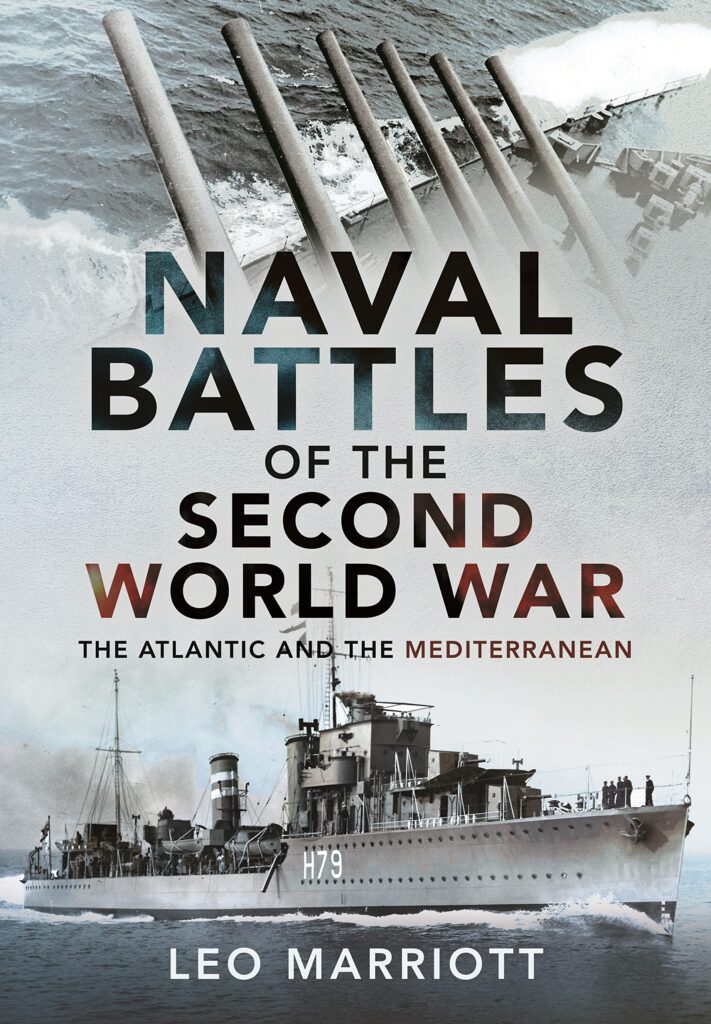Reviewed by Jeff Schultz
Leo Marriott’s Naval Battles of the Second World War: The Atlantic and Mediterranean offers a brief glimpse of select naval engagements involving the Royal Navy engaged against their major European foes, the Italian and German fleets.
Marriott is an established author with multiple books about a range of military, naval, and aviation topics covering mostly World War II and the Cold War. This 160-page book consists of nineteen brief sections divided into two larger segments as “Part I” which focuses on the Atlantic Ocean and NW Europe beginning with the Battle of the River Plate and “Part II,” which focuses on the Mediterranean ending with the Naval Battle of Casablanca, along with an introduction, glossary and abbreviations, warships appendix, select bibliography, and photo credits. The text uses a rough template for each of the nineteen sub-sections; providing a simple and standardized format as follows: location, date, list of opposing forces and leaders, background, specific events, photos and perhaps a map.
Marriott argues in this first of two volumes covering naval battles in World War II that, “this book is intended as a basic guide to the main naval engagements in each theatre of operations covered” while also establishing that amphibious operations are not the focus of the work; which should temper expectations regarding depth of coverage going forward.
To give an idea of the work, three of the nineteen engagement sections will be briefly discussed. An example from Marriott’s “Part I” is the infamous PQ-17 Arctic convoy battle of June-July 1942, which ranks up there as perhaps the worst example of a failed Allied coalition convoy effort in World War II in terms of losses to enemy action, particularly when the surface threat never materialized, accompanied by six photos and a map. The role of the German battleship Tirpitz does not escape mention, in particular the mere existence of the warship had a devastating impact on the convoy, along with the failed reconnaissance efforts which could not pinpoint the looming threat and the decisions made in reaction by British senior leadership. Sir Dudley Pound, First Sea Lord, and his staff set into motion a disastrous cascade of decisions which would eventually result in the loss of twenty-four of the thirty-three largely American merchant ships to a mixture of submarine and air attacks, the German surface forces that might have struck the convoy, including the Tirpitz, never actually got involved. The aftermath of the Allied defeat rippled outwards as another example of the worsening relationship between the Western Allies and the Soviet Union which would eventually culminate in the Cold War. This may be “one of the greatest disasters of the war” but it is not the only Allied embarrassment examined, as he also covers Narvik (1940), the sinking of HMS Glorious (1940) and Operation Cerberus (1942), etc.
A second example from “Part I” is the Battle of the Atlantic, which could easily occupy a much larger work than the mere five pages of text it gains, along with ten photos and a map, the longest treatment of any of the topics. Marriott provides a brief overview which quickly progresses from 1939 to 1945, critical not only for the survival of Great Britain but also “the longest battle, it was also the one that Britain and its allies could not afford to lose.” Even in such a short treatment of the subject, he does cover technological advances, Allied cryptographic successes, relevant statistics and other important elements of a colossal story. That said, it remains a scant look at a seminal battle that spans the entire war.
A third example, now in the Mediterranean, sees Marriott delve into the critical August 1942 attempt to resupply Malta during Rommel’s heyday, Operation Pedestal, supported by eight photos and a map. The beleaguered Allied convoy ran a vicious gauntlet of Axis air, surface and subsurface attacks which steadily reduced the valiant ships and escorts, yet the damaged tanker Ohio and four other vessels reached Valetta to discharge their vital cargoes allowing the island bastion to survive.
Finally, Marriott also includes Operation Judgement, the 1940 raid on Taranto, and Operation Catapult, the 1940 raid on Mers-el-Kébir, which are one-sided attacks on enemy anchorages, not battles in the classical sense. These are quizzical inclusions, given the other topics but he justifies Taranto as, “[it] materially altered the balance of power in the Mediterranean.” Another of his “main engagements” is the 1940 British morale-building sinking of a single Italian cruiser, the Bartolomeo Colleoni, which falls short considering the scale of the encounter, other potential battle inclusions and when compared with the likes of Operation Cerberus or Pedestal.
Leo Marriott’s Naval Battles of the Second World War: The Atlantic and Mediterranean is a brief monograph that acts as a perfunctory primer highlighting a number of clashes between the Royal Navy and the major European Axis fleets. Although this book does not go into great depth, it should be considered a launching point for learning about the war at sea during World War II but as an attempt to cover nearly twenty battles it can only really scratch the surface for those seeking a deeper assessment.
A past contributor, Schultz teaches history at a community college in Pennsylvania.
Naval Battles of the Second World War: The Atlantic and Mediterranean. By Leo Marriott (Barnsley, UK: Pen and Sword Maritime, 2022).


